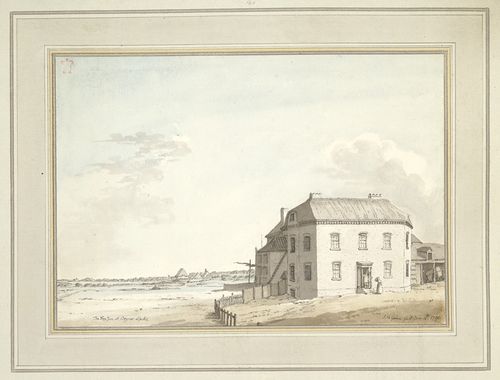Annotation:Bognor Rocks (1): Difference between revisions
No edit summary |
No edit summary |
||
| Line 1: | Line 1: | ||
'''Back to [[{{BASEPAGENAME}}]]''' | =='''Back to [[{{BASEPAGENAME}}]]'''== | ||
---- | ---- | ||
<p><font face="garamond, serif" size="4"> | <p><font face="garamond, serif" size="4"> | ||
'''BOGNOR ROCKS'''. English, Country Dance Tune (cut time). A Major. Standard tuning (fiddle). AAB. Bognor is a town on the Sussex coast, in the extreme south of England, near Chichester. 1870-72, John Marius Wilson described it in his '''Imperial Gazetteer of England and Wales''' (1870-72): | '''BOGNOR ROCKS'''. English, Country Dance Tune (cut time). A Major. Standard tuning (fiddle). AAB. Bognor is a town on the Sussex coast, in the extreme south of England, near Chichester. 1870-72, John Marius Wilson described it in his '''Imperial Gazetteer of England and Wales''' (1870-72): | ||
[[File:bognor.jpg| | [[File:bognor.jpg|500px|thumb|left|The Fox Inn at Bognor Rocks. Drawn on June 4th 1790 by S.H. Grimm]] | ||
<blockquote> | <blockquote> | ||
''The town was changed from an obscure hamlet to a fashionable watering-place, between 1786 and 1799, by Sir Richard Hotham, at a'' ''cost of about £60,000; and took, for a time, the name of Hothamston. It was frequented by Queen Charlotte and her children, in'' ''the time of George III.; and it then possessed a sort of exclusive character; but it afterwards became dependent on general'' ''public patronage. It comprises rows of brick houses, two squares open on one side to the sea, a crescent, a terrace, and several'' ''detached mansions; it possesses good lodginghouses, several hotels, and excellent bathing conveniences; and it has a church of'' ''1821, an Independent chapel of 1869, a Wesleyan chapel, a public school for 50 girls, a reading room, a circulating-library, a'' ''people's institute, a small annual regatta, and occasional races. Markets are held thrice a-week; and a fair on 5 July. The'' ''surrounding country is flat; and the Bognor rocks, famed by geologists, and not long ago forming a line of low cliffs along the'' ''coast, are now visible only at low water.'' | ''The town was changed from an obscure hamlet to a fashionable watering-place, between 1786 and 1799, by Sir Richard Hotham, at a'' ''cost of about £60,000; and took, for a time, the name of Hothamston. It was frequented by Queen Charlotte and her children, in'' ''the time of George III.; and it then possessed a sort of exclusive character; but it afterwards became dependent on general'' ''public patronage. It comprises rows of brick houses, two squares open on one side to the sea, a crescent, a terrace, and several'' ''detached mansions; it possesses good lodginghouses, several hotels, and excellent bathing conveniences; and it has a church of'' ''1821, an Independent chapel of 1869, a Wesleyan chapel, a public school for 50 girls, a reading room, a circulating-library, a'' ''people's institute, a small annual regatta, and occasional races. Markets are held thrice a-week; and a fair on 5 July. The'' ''surrounding country is flat; and the Bognor rocks, famed by geologists, and not long ago forming a line of low cliffs along the'' ''coast, are now visible only at low water.'' | ||
| Line 24: | Line 24: | ||
<br> | <br> | ||
---- | ---- | ||
'''Back to [[{{BASEPAGENAME}}]]''' | =='''Back to [[{{BASEPAGENAME}}]]'''== | ||
Revision as of 18:21, 2 May 2018
Back to Bognor Rocks (1)
BOGNOR ROCKS. English, Country Dance Tune (cut time). A Major. Standard tuning (fiddle). AAB. Bognor is a town on the Sussex coast, in the extreme south of England, near Chichester. 1870-72, John Marius Wilson described it in his Imperial Gazetteer of England and Wales (1870-72):

The town was changed from an obscure hamlet to a fashionable watering-place, between 1786 and 1799, by Sir Richard Hotham, at a cost of about £60,000; and took, for a time, the name of Hothamston. It was frequented by Queen Charlotte and her children, in the time of George III.; and it then possessed a sort of exclusive character; but it afterwards became dependent on general public patronage. It comprises rows of brick houses, two squares open on one side to the sea, a crescent, a terrace, and several detached mansions; it possesses good lodginghouses, several hotels, and excellent bathing conveniences; and it has a church of 1821, an Independent chapel of 1869, a Wesleyan chapel, a public school for 50 girls, a reading room, a circulating-library, a people's institute, a small annual regatta, and occasional races. Markets are held thrice a-week; and a fair on 5 July. The surrounding country is flat; and the Bognor rocks, famed by geologists, and not long ago forming a line of low cliffs along the coast, are now visible only at low water.
Source for notated version:
Printed sources: Preston (Preston's Twenty-Four Country Dances for the Year 1800), 1800.
Recorded sources:
